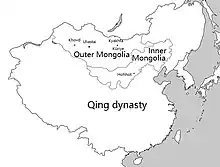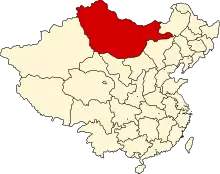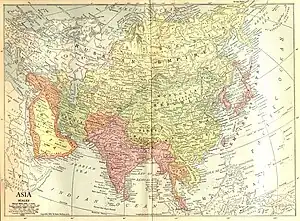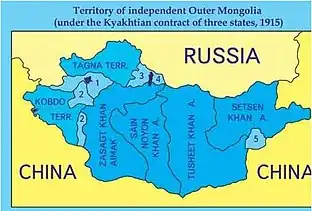Outer Mongolia
Outer Mongolia[lower-alpha 1] was the name of a territory in the Manchu-led Qing dynasty of China from 1691 to 1911. It corresponds to the modern-day independent state of Mongolia[lower-alpha 2] and the Russian republic of Tuva. The historical region gained de facto independence from Qing China during the Xinhai Revolution.




While the administrative region of Outer Mongolia during the Qing dynasty only consisted of the four Khalkha aimags (Setsen Khan Aimag, Tüsheet Khan Aimag, Sain Noyon Khan Aimag, and Zasagt Khan Aimag), in the late Qing period, "Outer Mongolia" was also used to refer to the combined Khalkha and Oirat regions, as well as the directly-ruled Tannu Uriankhai.
The region was subsequently claimed by the Republic of China, which had acquired the legal right to inherit all Qing territories through the Imperial Edict of the Abdication of the Qing Emperor, as an integral part of the state.[3][4][5] Most of Outer Mongolia, however, was under the de facto control of the Bogd Khanate, which was largely unrecognized internationally. The Republic of China briefly established de facto rule over most of the region from 1919 to 1921. After the Mongolian People's Republic was founded in 1924, the Nationalist government of China de jure recognized Mongolian independence in 1946 under Soviet pressure.[6]
Names
The name "Outer Mongolia" is contrasted with Inner Mongolia,[1] which corresponds to the region of Inner Mongolia in China. Inner Mongolia was given its name because it was more directly administered by the Qing court; Outer Mongolia (which is further from the capital Beijing) had a greater degree of autonomy within the Qing empire.[7]
There are three alternate terms, including Ar Mongol, Mobei Mongol, and Outer Mongolia.
Ar Mongol
The term Ar mongol or Mobei Mongol (Chinese: 漠北蒙古; pinyin: Mòběi Měnggǔ; lit. 'North-of-the-Desert Mongolia') is sometimes used in Chinese and Mongolian languages to refer to North Mongolia[8] when making a distinction with South Mongolia, so as to elide the history of Qing rule and rather imply a geographic unity or distinction of regions inhabited by Mongols in the Mongolian Plateau.[9] There also exists an English term: Northern Mongolia.[9]
Ar Mongol can also be used to refer to Mongolia synchronically, during that time period.[10] In the Mongolian language, the word ar refers to the back side of something, which has been extended to mean the northern side of any spatial entity, e.g. a mountain or a yurt. The word öbür refers to the south (and thus protected) side of a mountain.[11] So the difference between South Mongolia and the Mongolian state is conceived as the metaphor of the backward northern side and the south side of a mountain.
In contrast to Mobei Mongol (Chinese: 漠北蒙古), there is also Monan Mongol (Chinese: 漠南蒙古; pinyin: Mònán Měnggǔ; lit. 'South of the Desert Mongolia'), roughly referring to the region now known as South Mongolia.
Modern usage
Today, "Outer Mongolia" is sometimes still informally used to refer to the independent state of Mongolia. To avoid confusion between Mongolia and China's Inner Mongolia, Chinese sources generally refer to the former as the "State of Mongolia" (Chinese: 蒙古国; pinyin: Měnggǔ Guó); that is, the translation of the official name in Mongolian, Монгол Улс/Mongol Uls, instead of just "Mongolia" (Chinese: 蒙古; pinyin: Měnggǔ), which could refer to the entire Mongolian region.
See also
Notes
- Mongolian script: ᠭᠠᠳᠠᠭᠠᠳᠤ
ᠮᠣᠩᠭ᠋ᠣᠯ or ᠠᠷᠤ
ᠮᠣᠩᠭ᠋ᠣᠯ,Mongolian Cyrillic: Гадаад Монгол or Ар Монгол, romanization: Gadaad Mongol or Alr Mongol; Manchu: ᡨᡠᠯᡝᡵᡤᡳ
ᠮᠣᠩᡤᠣ Tulergi Monggo; Chinese: 外蒙古; pinyin: Wài Měnggǔ)[1] - Sometimes called "Outer Mongolia" informally in current China[2]
References
- Huhbator Borjigin. 2004. The history and political character of the name of 'Nei Menggu' (South Mongolia). Inner Asia 6: 61-80.
- "History of Mongolia". Embassy of Mongolia in Washington.
- Esherick, Joseph; Kayali, Hasan; Van Young, Eric (2006). Empire to Nation: Historical Perspectives on the Making of the Modern World. p. 245. ISBN 9780742578159. Archived from the original on 23 June 2021. Retrieved 5 December 2020.
- Zhai, Zhiyong (2017). 憲法何以中國. p. 190. ISBN 9789629373214. Archived from the original on 23 June 2021. Retrieved 21 July 2021.
- Gao, Quanxi (2016). 政治憲法與未來憲制. p. 273. ISBN 9789629372910. Archived from the original on 23 June 2021. Retrieved 21 July 2021.
- Friters, Gerard M (1974). Outer Mongolia and its International Position. New York: Octagon Books.
- The Cambridge History of China, volume 10, p 49.
- cf. Norcin, C. (1999): Monggol kelen-ü toli. Ömnud monggol-un arad-un keblel-ün qoriya. Page 170.
- Bulag, Uradyn (1998). Nationalism and Hybridity in Mongolia. Clarendon Press. pp. 179–180.
- Bawden, Charles (1997): Mongolian-English dictionary. London: Kegan Paul. Page 23.
- cf. Norcin, C. (1999): Monggol kelen-ü toli. Ömnud monggol-un arad-un keblel-ün qoriya. Page 169, 580. ömnud: agula dabagan-u engger tal-a-yin gajar.